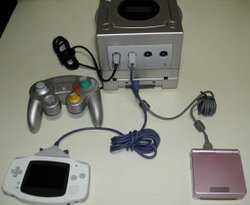Game Boy Player
|
|
Gameboy_player.JPG
The Game Boy Player is a device made by Nintendo for the Nintendo GameCube which enables Game Boy, Game Boy Color, or Game Boy Advance cartridges to be played on a television. It connects via the High Speed (Parallel) port at the bottom of the GameCube and requires use of a boot disc to be run to access the hardware. The hardware in the Game Boy Player is the same as a Game Boy Advance without the screen or batteries. The Game Boy Player is not compatible with Game Boy Advance Video paks for copy prevention reasons; see Game Boy Advance Video for details.
The Game Boy Player is available in Indigo, Black, Spice, or Platinum in Japan; Black in North America and Europe; and Black and Indigo in Australia. A special Game Boy Player for the Q GameCube/DVD player had to be made due to the Q's legs. All Game Boy Players have screws on the bottom to secure it to the bottom of the GameCube and also have an eject button on the right side of the unit for removing Game Boy Advance games. Game Boy and Game Boy Color games stick out from the unit, as with the Game Boy Advance and Game Boy Advance SP, so they can just be pulled out when the system is off or Change Cartridge has been selected from the menu. Prototypes have featured a storage compartment on the left side of the Game Boy Player, but it is not featured in the retail product.
Controllers
The Game Boy Player allows for control either through a GameCube controller or a Game Boy Advance or Game Boy Advance SP hooked up with a GameCube-Game Boy Advance Cable. When using a Game Boy Advance, the buttons are identical, but due to the GameCube controller's different layout, there are two different mappings you can use. Also, at least one GameCube controller must be plugged in for access the Game Boy Player's internal menu, which can be accessed by pressing the Z button. For some special GBA games, the rumble feature can be enabled on the GameCube controller in Controller Socket 1.
All controllers, Game Boy Advances, and Game Boy Advance SPs connected to GameCube are recognized as same player. If players want to link other hardware, they'll need to connect to the extension port on the Game Boy Player with the proper cable, which depends on whether the game was designed for Game Boy Advance or a Game Boy system released before the Game Boy Advance.
| GameCube Button | GBA Equivalent - Map One | GBA Equivalent - Map Two |
|---|---|---|
| Control Stick/Directional Pad | Directional Pad | Directional Pad |
| A/B Buttons | A/B Buttons | A/B Buttons |
| L/R Buttons | L/R Buttons | Select |
| X/Y Buttons | Select | L/R Buttons |
| Start Button | Start Button | Start Button |
| C Stick | Not Used | Directional Pad |
| Z Button | Open Menu | Open Menu |
Map One is closer to the Game Boy Advance's normal layout, while Map Two makes it easier to play with one hand.
On-screen menu
The menu has six options to choose from:
- Frame: changes the colored border around the game "screen" to one of twenty different patterns. Super Game Boy borders are not supported.
- Size: changes the size that the GBA screen takes up on the TV (Normal is about 80% while Full enlarges the image to the left and right edges of the TV)
- Controller: switches between the two controller mappings
- Screen: switches between soft, normal, or sharp contrast to reduce potential flicker from programming tricks designed for a GBA screen
- Timer: set an alarm for one to sixty minutes
- Change Cartridge: stops the game so cartridges can be swapped safely, without having to turn the GameCube off (it is best to save game data before doing so)ja:ゲームボーイプレーヤー

